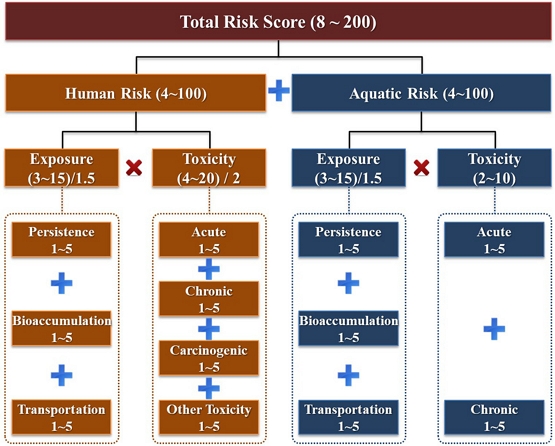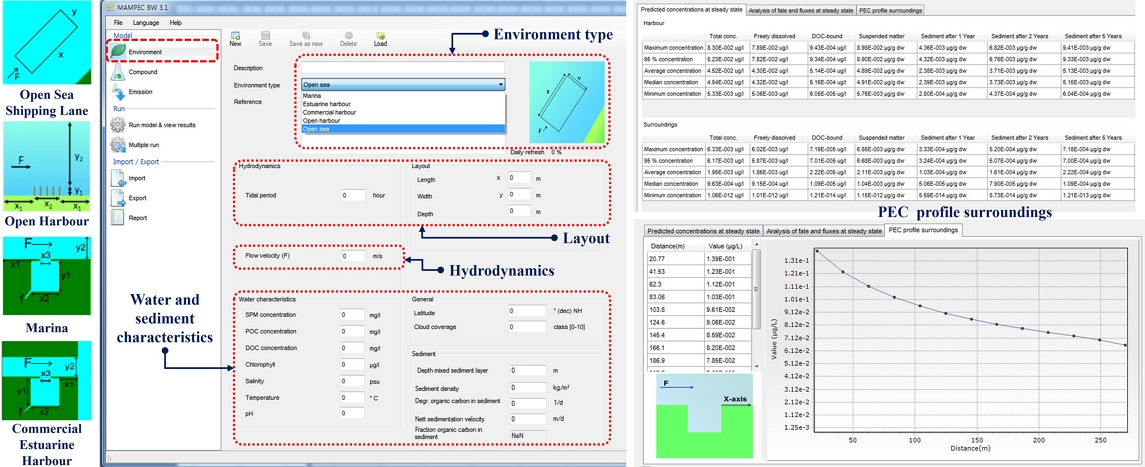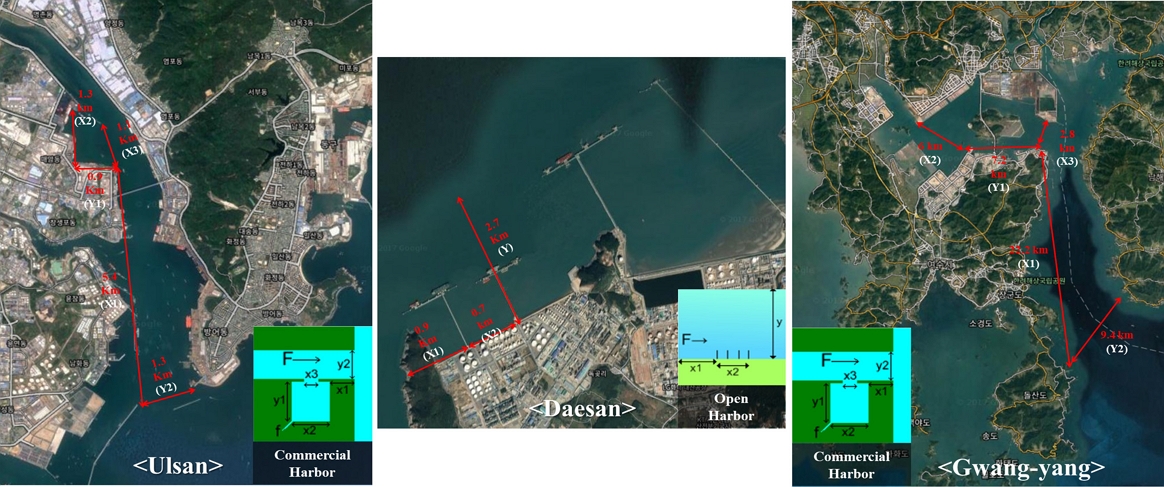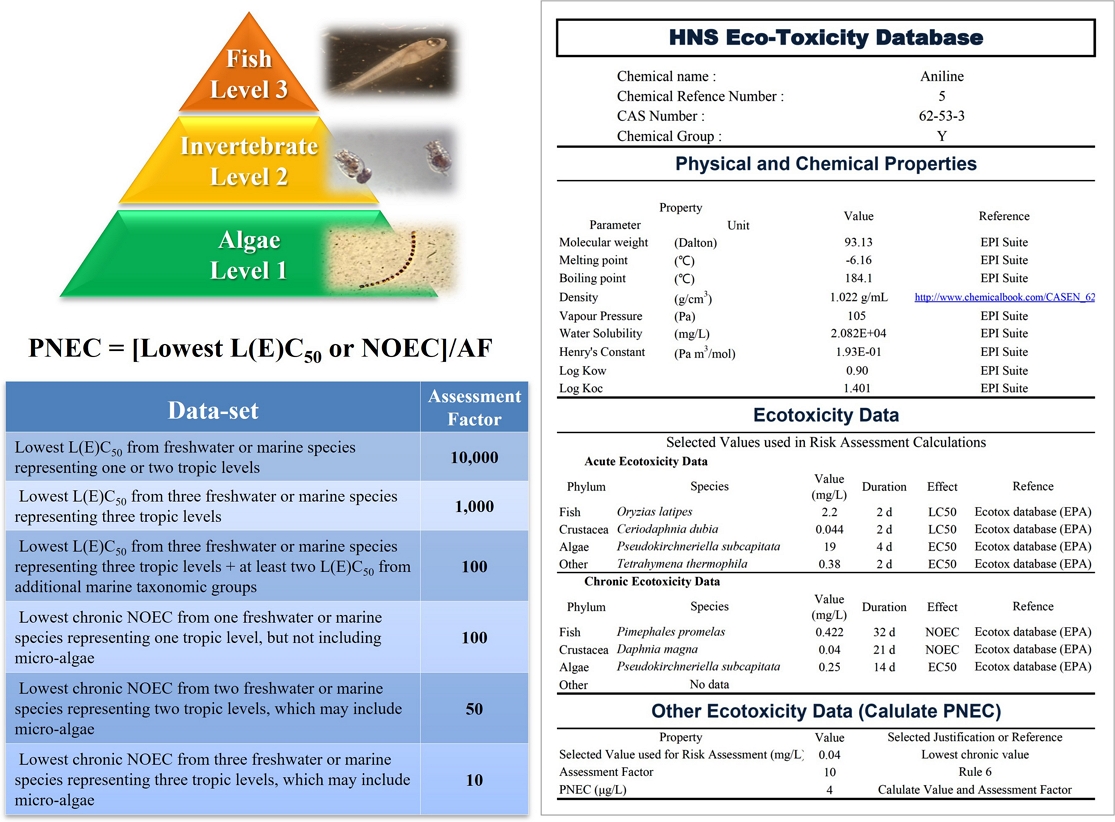
국내 주요 항만의 위험·유해물질(HNS) 유출 사고 후 해양생태 위해성 평가
초록
국내 위험·유해물질(HNS) 물동량 상위 3개 항만(울산, 광양, 대산)을 대상으로 최악 및 대안의 유출 사고시나리오에 따른 생태 위해성을 평가하여 해양생태계 보호 측면의 중점관리물질을 파악하였다. 노출평가를 위해 MAMPEC-BW 모델을 이용하여 예측환경농도(PEC)를 산출하였고 HNS 사고대비물질 군의 생태독성 데이터베이스로부터 무영향예측농도(PNEC)를 도출하였다. 생태 위해도는 유해지수(HQ=PEC/PNEC)를 산출하여 결정하였다. 위해성 평가 결과를 바탕으로 해양생태계 보호 측면에서 위해도 저감 조치 등이 필요한 중점관리물질을 항만별로 제시하였다. Allyl alcohol과 Ethylenediamine의 경우에는 대안시나리오에서도 수생태계 급성독성 영향이 크게 나타나므로 사고관리에 주의가 요구된다. 향후 연구에서는 사고대비물질 군 갱신, 생태독성 정보 보완, 종민감도분포 활용, 노출평가 모델 개선이 필요하며, 나아가 국내 HNS 취급 항만 전체를 대상으로 해양생태 위해성 평가를 수행하고 항만별 중점관리물질을 도출해 볼 필요가 있을 것이다.
Abstract
To identify priority control Hazardous and Noxious Substances (HNS), in terms of marine ecosystem protection, ecological risk was evaluated according to the worst and alternative spill incident scenarios in the top three ports (Ulsan, Gwangyang and Daesan) of the HNS volume. For exposure evaluation, the predicted environmental concentration (PEC) was calculated using the MAMPEC-BW model. Predicted no effect concentration (PNEC) was derived from the ecotoxicity database of the priority HNS. Marine ecological risk was characterized by calculating the hazard index (HQ=PEC/PNEC). Based on the results of the risk evaluation, priority control HNS that require risk reduction measures, in terms of protecting the marine ecosystem, were presented for each port. Allyl alcohol and Ethylenediamine have an acute toxic effect on the aquatic ecosystem in alternative scenarios, so attention is required in accident management. In future studies, it is necessary to update the priority HNS group, supplement ecotoxicity information, apply the species sensitivity distribution (SSD), and improve the environmental exposure evaluation model. Furthermore, it will be necessary to conduct an marine ecological risk assessment for all HNS-handled ports in Korea and derive the priority control HNS for each port.
Keywords:
HNS spill, Marine ecological risk assessment, PNEC, MAMPEC-BW model, Hazard Quotient키워드:
HNS 유출 사고, 해양생태 위해성 평가, 무영향예측농도, 예측환경농도 모델, 유해지수1. 서 론
전 세계 유류의 해상 물동량은 1980년 이후 꾸준한 증가 추세이나 같은 기간 동안 유류 유출 사고는 지속적으로 감소하고 있고 현재는 운송되는 유류의 99.99%가 안전하게 목적지까지 도달하고 있다(ITOPF[2021]). 반면 국내 위험·유해물질(HNS)의 화물 물동량은 2006년 대비 2015년에 10년간 약 47.3%가 증가한 것으로 나타났고 비슷한 기간인 2005년부터 2014년까지 HNS 사고도 총 28건 발생하여 총 2,572톤이 유출된 바 있다(Kim et al.[2015]). 유류 유출사고와는 달리 HNS 사고는 유해성, 위험성, 물리·화학적 특성이 다양한 물질들이 운송됨에 따라 사고 발생 시 대응 및 영향 파악이 어렵고 유류 유출 사고처럼 사고 대응 및 관리 경험도 부족한 상황이다. 이에 국외에서는 HNS 사고관리를 위해 유럽과 국제기구 등을 중심으로 최근 20년간 과거 HNS 사고 이력 분석 및 데이터베이스 구축(Cunha et al.[2015]), 우선관리 물질 선정(Harold et al.[2014]; Neuparth et al.[2011, 2012]), 생태독성 평가(Neuparth et al.[2013]), 위해성 평가(Soares et al.[2020]), 사고 대응 매뉴얼 개발(Alcaro et al.[2021]) 등 다양한 연구 결과들을 보고하고 있다. 국내에서도 2015년부터 해양수산부 주도로 “위험유해물질 사고관리 기술 개발”사업이 진행되고 있으며 이를 통해 우선관리 HNS 선정(Kim et al.[2015], Kim et al.[2016]), 해양생태 초기 위해성 평가(Kim et al.[2019]) 등 사고 대비, 대응 및 사후관리 기술에 관한 다양한 연구결과들이 보고되고 있다. HNS는 그 종류가 매우 방대하므로 사고관리를 위해서는 가장 먼저 관리대상 HNS를 정의하고 우선관리 물질을 선정해야 하며 이때 위해성 평가를 활용할 수 있다. 이와 관련한 선행연구로써 국내 주요 항만에서 HNS 유출 사고가 발생할 경우 해양생태계에 미치는 영향이 큰 물질들을 파악하기 위해 국내 물동량 상위 3개 항만에서 0순위 사고대비물질 군(群) 18종(Kim et al.[2016])의 유출 사고시나리오에 따른 해양생태 초기 위해성 평가가 수행된 바 있다(Kim et al.[2019]). 본 연구에서는 이 선행연구의 사고대비물질 군 범위를 확장하여 3개 항만에서 0~3순위 물질군 59종의 유출 사고시나리오에 따른 해양생태 위해성을 평가하여 항만별 중점관리물질을 선정하고자 하였다.
2. 재료 및 방법
2.1 평가 대상 HNS
우선관리 HNS의 선정을 위한 선행연구에서는「선박에서의 오염 방지에 관한 규칙 별표 1」에 따른 유해액체물질(545종) 및 2014~2015년 항만별 물동량 자료에서 유통되는 것으로 추가 확인된 물질을 포함하여 총 596종에 대한 위해성 정보 데이터베이스를 구축한 바 있다(Kim et al.[2015]; Kim et al.[2016]). 이후 Fig. 1과 같이 인체 및 해양환경으로의 유해성과 노출에 기반한 CRS (Chemical ranking and scoring) 시스템을 구축하고 위해도 점수에 따라 우선순위를 선정하였다(Table 1). 전체 물질의 우선순위 중 국내 12개 항만으로 유통이 확인된 물질을 선별한 결과 158종이었으며, 0~3순위의 4개 사고대비물질 군으로 구분하고 항만별 관리전략을 제언한 바 있다(Kim et al.[2016]). 사고대비물질 군은 0순위 물질 군 34종, 1순위 물질 군 44종, 2순위 물질 군 39종, 3순위 물질 군 41종으로 구성되어 있으며 항만별 2014~2015년 물동량, MARPOL의 오염분류(X, Y, Z, OS류), 사고 이력 등 7개 기준을 적용하여 구분하였다(Kim et al.[2016]). 국내 12개 HNS 취급 항만 중 2014, 2015년 기준으로 HNS 물동량이 가장 많았던 항만은 울산, 광양, 대산항의 순서였다(Table 2). 이들 항만별로 사고대비물질 군 유통 현황을 분석하고 GESAMP[2014, 2016] 자료를 바탕으로 해양환경 유출 시 생물과 퇴적물에 영향을 미칠 가능성이 있는 용존태(D, DE, ED, FD, FED, SD) 물질을 선별하였으며 상업제품명으로 유통되는 물질들은 제외하고 각각 울산항 49종, 광양항 40종, 대산항 12종을 평가 대상 물질로 선정하였다.

Information on risk database and numerical rating criteria for prioritizing hazardous and noxious substance
2.2 노출시나리오
노출시나리오는 충돌로 인한 선박 파공이나 작업자 실수로 인한 해양환경으로의 누출사고를 가정하여 개발하였으며 화재나 폭발사고는 제외하였다. 최악시나리오의 유출량 설정에 관한 국내외 사례를 살펴보면 국제석유산업환경보호협의회(IPIECA[2000])와 Lee and Jung[2013]은 해양오염 사고 이력 자료를 바탕으로 사고 선박 선복량과 유출량과의 회귀분석을 수행하여 약 10,000톤의 최대가능 유출량을 제시한 바 있다. 일본에서는 해난사고 시 유출량을 선복량의 9%로 추정한 바 있고 캐나다는 10,000톤으로 설정하고 있다(Lee and Jung[2013]). 국내 HNS 산적 운송 선박의 최대 선복량은 60,000톤으로 보고된 바 있으나(Lee and Jung[2013]) 실제 위험물 해상운송 시 한 선박에 같은 물질을 최대로 선적하는 경우는 물량이 없어 극히 일부이며 대부분 선박 내 탱크별로 각기 다른 물질들을 선적하여 운송하는 것으로 나타났다. 산적액체위험물 운송 선박은 선박 내에 저장탱크가 각각 구분되어 있으며, “산적액체위험물 운송 선박의 시설 등에 관한 기준”(해양수산부 고시 제2015-96호) 제170조(선형의 분류)에 따르면 선박은 화물의 위험성 및 유출 방지 조치 등에 따라 형식 1, 2, 3으로 분류되며 동 기준 별표 5(액체화학품 물질별 설비 등의 적용기준)의 선형란에 정하는 선형별 구분에 따라 운송하게 되어 있다. 또한, 제182조(최대허용화물량)에 따르면 각 형식1 선박의 화물 적재량은 1개 탱크에 대해 1,250 m3을 초과할 수 없고 형식2 선박의 화물은 1개 탱크에 3,000 m3을 초과할 수 없도록 규정되어 있다. 상기 기준에 따라 평가대상 HNS의 선형을 확인해 본 결과 2형 및 3형으로 분류되어 최대허용 화물량은 탱크당 3,000 m3 이었다. 따라서 본 연구에서는 최악시나리오의 유출량을 선박 1개 탱크에서 화물 수송관(최대지름 150 mm)의 손상으로 인해 화물 3,000 m3이 전량 유출되는 것으로 가정하였다. 대안시나리오의 누출조건은 최악시나리오와 같게 설정하고 현실적인 유출량을 반영하기 위해 해양경찰청의 1996~2017년 해양오염사고 통계자료를 분석한 결과 평균 유출량이 606.7 kL이었고, 이에 대안 시나리오에서는 비중을 약 1로 가정하여 유출량을 600 m3으로 설정하였다.
2.3 노출평가 모델
사고시나리오에 따른 해양환경 내 물질 거동 모의를 위해 MAMPEC-BW (Ver. 3.1.0.2, Deltares, Netherlands) 모델을 이용하였다. 이 모델은 IMO MEPC(해양환경보호위원회)의 선박평형수처리장치 형식 승인 과정에서 위해성 평가에 적용되고 있는 모델이다. MAMPEC-BW 모델은 수력학 및 화학물질 거동을 통합한 2차원 정상상태 모델이며 일반화한 4가지 해양환경(Open harbour, Marina, Open sea, Commercial harbour, Fig. 2 좌측)에서 화학물질 농도의 공간분포를 예측할 수 있다(van Hattum et al.[2016]). MAMPEC-BW 모델의 구동을 위해 모델에서 제공하는 기본 4가지 항만 유형 중 울산·광양항은 Commercial estuarine harbour와 대산항은 Open harbour와 가장 유사한 구조와 형상을 나타내고 있어 각각 상기 유형으로 설정하였다(Fig. 2, 3). 수력학적 입력 인자로서 조석주기, 유속 자료는 국립해양조사원의 실시간 해양관측 시스템에 공개되어 있는 대상 해역 주변의 조석 및 조류자료(30일 연속 관측)를 취득하여 대조기, 소조기 및 30일간의 평균값을 산정하여 각각 적용하였으며 최악의 상황을 가정하기 위하여 해수 교환이 가장 약한 소조기의 결과를 이용하였다(Fig. 4). 수질 및 퇴적물 자료는 국가해양환경종합정보시스템(MEIS)의 해양환경측정망 정점 중 각각 울산, 광양, 대산항 인근 정점의 5년간(2012~2016) 분기별 조사 결과의 평균값을 적용하였고 측정망 자료에 없는 항목의 경우 국내 출판된 논문자료를 활용하여 입력하였다.

List of the HNS with basic information for marine environmental risk assessment at the top three ports of traffic quantity
2.4 무영향예측농도(PNEC) 데이터베이스(DB)
노출시나리오에 따라 MAMPEC-BW 모델을 통해 예측환경농도(PEC, Predicted environmental concentration)를 계산하였고 US EPA ECOTOX 등 생태독성 데이터베이스로부터 평가대상 HNS의 생태 독성 DB를 구축하고 이 자료들로부터 무영향예측농도(PNEC, Predicted no effect concentration)를 산정하였다. 위해도는 PEC와 PNEC의 비인 유해지수(Hazard Quotient=PEC/PNEC)를 산출하여 결정하였다. PNEC 산정 시 물질별로 이용 가능한 독성자료의 수에 따른 불확도를 반영하기 위해 평가계수(Assessment factor, AF)를 적용하여(IMO[2017]) 물질별 PNEC DB를 구축하였다(Fig. 5). PNEC DB에는 PEC 산출 MAMPEC-BW 모델의 입력 자료인 물리·화학적 특성 자료도 포함되어 있다. PNEC DB는 향후 CHEMMAP(RPSgroup[2022])이나 Soares et al.[2020]과 같은 수준의 정교한 노출 모델이 개발되면 생태계 영향범위를 결정할 수 있는 입력 자료로 활용할 수 있을 것이다.
2.5 위해도 결정
위해도 결정을 위해 유해지수 값에 따른 위해도 분류기준을 설정하였고(Table 4). 분류기준은 유럽화학물질관리청에서 제시한 신규 화학물질의 수생태 위해성 결정 시 의사결정 체계의 내용을 적용하였다(De Bruijn et al.[2002]; Kim et al.[2019]). A 등급(HQ<1). 물질은 해양환경에 유출 시 수생태계에 미치는 해로운 영향이 나타날 가능성이 작으며, 큰 영향 없이 관리대상에서 제외할 수 있음을 의미한다. B 등급(HQ, 1~10) 물질은 해로운 영향을 배제할 수 없으며 추가실험 및 평가가 필요한 물질임을 의미한다. C 등급(HQ, 10~100) 물질은 조속한 추가실험 및 평가가 필요한 물질을 의미한다. D 등급(HQ>100) 물질은 주요 관심 물질로써 위해도가 높아 위해 저감 조치가 필요한 물질을 의미한다. E 등급 물질은 현재 가용한 정보가 부족하여 평가할 수 없음을 의미하며 정보 확보가 시급한 물질이다.
3. 결과 및 고찰
3.1 사고대비물질 군의 항만별 해양생태 위해성 평가 결과
항만별 0순위 물질 군 중 용존성 물질의 최악시나리오에 따른 위해성 평가 결과 Nitric acid(울산항 HQ=2.4, B), Ethylene dichloride(광양항, HQ=4.2, B)를 제외하고는 모두 유해지수가 C, D등급으로 생물에게 영향을 미칠 가능성이 클 것으로 예상되며 추가 시험 및 정밀평가가 필요한 물질이었다(Table 5). Ethyl alcohol(광양항, HQ=8, B)의 경우 광양항에서만 유의하게 낮은 유해지수를 보였는데 이는 노출평가 모델에서 울산과 같은 항만 유형(Commercial harbour)을 설정했으나 레이아웃 설정에서 거리 등의 입력 수치가 광양항이 더 커서 나타난 차이로 추측된다. 선박으로 운송되는 화학물질의 유해성을 평가하기 위해 UN 산하 해양환경전문가그룹(GESAMP)에서는 유해성 평가 절차에 관한 가이드라인을 개발한 바 있고(GESAMP[2019]), 이 가이드에 따라 GESAMP 전문가들이 선박으로 운송되는 화학물질들의 유해성 평가 결과를 매년 보고하고 있다(GESAMP[2021]). 평가대상 0순위 물질 중 평가계수(AF)가 10,000으로 설정된 5종 물질들은(Sulphuric acid, Sodium hydroxide solution, Hydrochloric acid, Vinyl acetate, Methyl methacrylate) 산, 염기 등으로 용해도가 크고 급성독성 영향이 나타날 가능성이 있는 물질이지만 해수의 완충능력으로 인해 만성적인 독성영향은 작을 것으로 예상된다. GESAMP[2021]의 유해성 평가 결과에서도 급성독성(LC/EC/IC50) 10~100 ppm 수준으로 급성독성 영향이 우려되지만, 생물축적성이나 만성독성 영향은 작을 것으로 평가하고 있었다. 상기 5종 물질은 생물 영양단계별 독성자료도 부족한 상황이므로 해양생물을 대상으로 한 급·만성 독성 등의 유해성 정보를 생산할 필요가 있을 것으로 생각된다. 0순위 물질 군의 대안시나리오 평가 결과에서는 울산항, 광양항에서 Ethyl Alcohol, Sulphuric acid, Sodium hydroxide solution과 같이 용해도가 높고 급성독성 영향을 보이는 산, 염기류 물질들이 B등급으로 분류되었고, 나머지 물질들은 모두 A등급으로 분류되어 수생태계 영향이 작을 것으로 평가되었다. 항만별로는 해수 순환이 가장 원활한 물리적 구조를 가진 대산항에서의 유해지수 값이 가장 낮았고 울산항에서 가장 높았다. 질산의 경우, 3개항 모두 최악시나리오에서도 수생생물에 미치는 영향이 나타날 가능성이 거의 없거나 작을 것으로 평가되었고, 이와 비슷한 물질들도(인산, 염산, 황산) 급성독성 영향을 제외하고는 해수의 완충작용과 확산에 의한 희석으로 생물 축적성, 만성독성 영향은 작을 것으로 판단된다.

Results of marine environmental risk characterization of group “0 and 1” substances in Ulsan, Gwangyang, and Daesan port at neap tide
항만별로 1순위 물질 군의 최악시나리오 평가 결과, 울산항은 Isopropyl alcohol(이하 IPA)을 포함한 9종, 광양항에서는 IPA 포함 4종, 대산항에서는 4종 중 Propylene glycol 만 D등급으로 분류되어 수생태계 영향 가능성이 클 것으로 예상되는 물질이었다(Table 5). 울산항에서만 유통되고 있는 Tetrahydrofuran, Propylene oxide, Chloroform은 추가 시험 및 세부 평가가 필요한 C등급으로 분류되었다. Epichlorohydrin, Dimethylformamide, tert-Butyl Alcohol, Methyl ethyl keton, Methyl isobutyl ketone은 최악시나리오에서도 B등급으로 다른 물질들에 비해 영향 가능성이 상대적으로 작을 것으로 예상되지만, 추가적인 시험과 평가 등의 보완이 필요하다. GESAMP[2021]의 유해성 평가 목록을 검토해 본 결과 Butylene glycol은 수생태계 유해성이 낮았고 2-Ethylhexanoic acid는 생물축적성, 수생태 급성독성(L(E)C50: >10~ ≤ 100 mg/L)이 나타나는 것으로 보고하고 있었다(GESAMP[2019]). 1순위 물질 군의 대안시나리오에서는 3개 항만 모두에서 모든 평가물질이 A등급으로 분류되어 해양생태계에 미치는 영향이 거의 없을 것으로 평가되었다.
2, 3순위 물질 군은 3개 항만 중 울산과 광양항에서만 유통되었고 4개 물질을 제외하고는 항만별로 유통되는 물질이 모두 달랐다(Table 6). 울산항 2순위 물질 군의 최악시나리오 평가 결과 Allyl alcohol을 포함한 7종이 D등급으로 분류되었고 Magnesium chloride solution 포함 4종 물질은 최악유출시나리오에서 B등급으로 분류되어 다른 물질들에 비해 영향 가능성이 작을 것으로 평가되었다(Table 6). 울산항 2순위 물질의 대안시나리오에서는 Allyl alcohol D등급, Ethylendiamine이 C등급으로 분류되어 과거 해양오염 사고 시 평균 유출량 수준임에도 수생태계에 영향 가능성이 큰 것으로 나타났고, 나머지 11개 물질은 영향 가능성이 없거나 작을 것으로 나타났다. Allyl alcohol은 생물축적성이 없고, 생분해되지만 수생태계에 미치는 급성독성(L(E)C50: >0.1~≤1mg/L) 영향이 크고, Ethylenediamine도 급성독성이 강한 물질로(L(E)C50>1~ ≤ 10) 보고된 바 있다(GESAMP [2019]; GESAMP[2021]).

Results of marine environmental risk characterization of group “2 and 3” substances in Ulsan and Gwangyang port at neap tide
울산항 3순위 물질 군 4종은 정보가 부족하여 평가할 수 없었으나, GESAMP[2021]의 유해성 평가 결과 목록을 검토해 본 결과 Molasses, Paraldehyde, Poly (2-8) alkylene glycol monoalkyl (C1-C6) ether는 수생태계에 미치는 영향이 없는 것으로 평가되었고, Diethylene glycol dibutyl ether는 약한 급성독성, Poly(2-8) alkylene glycol monoalkyl (C1-C6) ether acetate는 생분해되지 않고 약한 급성독성이 있는 것으로 평가하고 있었다.
광양항 2, 3순위 물질 군의 최악시나리오 평가 결과 Ethyl acrylate 포함 4종이 유해지수 D등급, Nitrobenzene, Potassium chloride solution, Diethylene glycol dibutyl ether는 C등급으로 수생태계 영향 가능성이 클 것으로 평가되었다. 광양항 2순위 물질 중 Methacrylic acid를 포함한 4종은 최악시나리오에서도 수생태계 영향 가능성이 작거나 없었고, 대안시나리오에서는 2~3순위 물질 모두 수생태계 영향 가능성이 없는 것으로 평가되었다.
3.2 항만별 중점관리 대상 물질
HNS 물동량 상위 3개 항만의 해양생태 위해성 평가 결과를 바탕으로 항만별로 집중관리가 필요한 물질들을 선정하였다(Table 7). 선정된 물질은 최악의 유출 사고(3,000 m3) 시나리오 기반의 결과이며 울산항 33종, 광양항 25종, 대산항 9종이 중점관리 대상 물질로 선정되었다. 특히 울산항에서만 유통되고 있는 Allyl alcohol, Ethylenediamine의 경우에는 지난 20년간의 해양오염사고 평균 유출량 수준인 대안 유출시나리오(600 m3)에서도 수생태계 급성독성 영향이 큰 것으로 나타나므로 울산항뿐만 아니라 다른 항에서도 유통될 경우를 대비하여 사고 대응 및 사후관리 대책 등이 필요할 것으로 판단된다. 먼저 이들 물질의 사고관리를 위해 물질들의 물리·화학적 특성, 수생태계 및 인체 위해성 정보, 사고 시 대응 정보, 사후복구 및 모니터링 방법에 관한 정보 등을 수록한 핸드북, 매뉴얼 등을 제작하여 항만 인근의 담당 방제 기관 또는 민간 방제업체 등에 비치하고 사고 대비를 위한 교육 시에도 교재로 활용할 수 있도록 해야 할 것이다.
3.3 해양생태 위해성 평가 결과에 미치는 영향 요인 및 개선방향
본 연구에서는 항만별로 중점관리가 필요한 HNS를 선별하기 위한 목적으로 가상의 유출 사고시나리오에 따른 해양생태 위해성 평가를 수행하였다. “환경유해인자의 위해성 평가를 위한 절차와 방법 등에 관한 지침”(환경부예규 제 585호) 별표 7에 따르면 생태 위해성 평가는 초기위해성평가와 매체통합 위해성 평가 단계로 구분할 수 있으며 본 연구는 우선평가 대상 물질 도출 목적의 초기 위해성 평가에 해당한다. 초기 위해성 평가 단계 중 생태 영향평가 시 평가계수법을 활용하는데 독성정보가 부족할 경우 평가계수가 높아지게 된다. 본 연구에서도 Table 4, 5의 평가계수 값이 1,000 이상으로 높은 물질들이 많이 있으므로 이들 물질에 대한 독성시험 자료를 확보하여 평가 신뢰도를 높일 필요가 있고 장기적으로는 종민감도분포곡선을 활용한 생태독성 영향의 평가 방안도 고려해야 한다. 또한, 선행연구에서 선정된 바 있는 우선관리 물질 158종의 위해성 정보 데이터베이스를 주기적으로 갱신할 수 있는 시스템의 개발이 필요하며, 최근 유해액체물질 목록이 기존 545종에서 799종으로 확대, 고시됨에 따라 새로운 물질들에 대한 정보 구축도 필요하다. Kim et al.[2016]에서도 강조하였듯이 HNS 사고 예방, 대비, 대응 및 사후관리를 위해 국내 항만별 HNS 운송량 정보가 공유되고 주기적으로 갱신되는 시스템도 조속히 구축되어야 할 것이다. 한편, 본 연구에서는 예측환경농도(PEC) 도출을 위해 MAMPEC-BW 모델을 적용했으나 장래에는 국내 HNS 사고관리를 위해 수중 및 대기로의 확산도 고려할 수 있는 CHEMMAP software (RPSgroup [2022]), Soares et al.[2020] 수준의 모델 개발이 필요하다. 또한, 이를 바탕으로 실제 사고나 사고시나리오에 따른 해양생태 위해성 평가 및 영향범위 설정 등이 소프트웨어 내에서 분석, 구현될 수 있도록 개발될 필요가 있으며 이때 본 연구에서 구축한 158종 우선관리 HNS의 PNEC DB를 활용할 수 있을 것이다. 마지막으로 향후 전술한 사항들의 보완을 통해 물동량 상위 3개 항만뿐만 아니라 HNS를 취급하는 항만 전체를 대상으로 위해성 평가를 수행하고 중점관리물질을 선정하는 후속 연구도 진행될 필요가 있다.
4. 결 론
국내의 HNS를 취급하는 주요 항만에서 유출 사고 발생 시 해양생태계 보호 목적의 중점관리물질 선정을 위해 가상의 유출 사고시나리오에 따른 해양생태 위해성 평가를 수행하였다. 선행연구를 통해 선정된 우선관리 물질 158종과 이들을 0~3순위의 사고대비 물질 군으로 구분한 결과를 바탕으로 항만별로 이들 물질의 취급 현황을 파악한 뒤 해양환경으로 유출 시 용존되는 물질들을 선별하고 해양생태 위해성을 평가하였다. 평가 결과 위해도가 높아 위해도 저감 대책 마련 등의 중점관리가 필요한 물질로 울산항 33종, 광양항 25종, 대산항 9종을 제시하였다. Allyl alcohol, Ethylenediamine의 경우 현실적인 유출량을 고려한 대안시나리오에서도 수생태계 급성독성 영향이 크게 나타나므로 사고관리에 주의가 필요할 것으로 판단된다. 본 연구는 HNS 취급 항만별 중점관리물질의 선별을 위한 스크리닝 개념의 초기 위해성 평가이다. 향후 후속 연구에서는 사고대비물질 군의 갱신, 생태독성 정보의 보완, 종민감도분포 활용, 노출평가 모델의 개선 등을 통해 HNS를 취급하는 항만 전체를 대상으로 한 위해성 평가를 수행하고 중점관리물질을 도출해볼 필요가 있을 것이다.
Acknowledgments
이 논문은 2022년도 해양수산부 재원으로 해양수산과학기술진흥원의 지원을 받아 수행된 연구입니다(20210660, 해양산업시설 배출 위험유해물질 영향평가 및 관리기술 개발).
References
- Alcaro L., Brandt J., Giraud W., Mannozzi M., Nicolas-Kopec A, 2021, Marine HNS Response Manual. Multi-regional Bonn Agreement, HELCOM, REMPEC. Printed in Malta - Impressions Limited Project WestMopoco, 321p.
- GESAMP, 2014, Revised GESAMP Hazard Evaluation Procedure for Chemical Substances Carried by Ships (IMO/FAO/UNESCO-IOC/WMO/IAEA/UN/UNEP/UNIDO/UNDP). Joint Group of Experts on the Scientific Aspects of Marine Environmental Protection (GESAMP No. 64).
- GESAMP, 2016, GESAMP Composite List 2016 Issued June 2016 as PPR.1/Circ.3. Replaces all Previous Versions. http://www.imo.org/en/OurWork/Environment/PollutionPrevention/ChemicalPollution/Documents/GESAMP%20CompList%202016.pdf, , Accessed date: 12 August 2018.
- GESAMP, 2019, GESAMP Hazard Evaluation Procedure for Chemical Substances Carried by Ships, 2019. Joint Group of Experts on the Scientific Aspects of Marine Environmental Protection, Rep. Stud. GESAMP No. 102.
- GESAMP, 2021, GESAMP Composite List 2021 Issued June 2021 as PPR.1/Circ.11. Replaces all Previous Versions. http://www.gesamp.org/site/assets/files/2228/report_of_the_58th_session.pdf, . Accessed date: 31 August 2022.
-
Harold, P.D., de Souza, A.S., Louchart, P., Russell, D., Brunt, H., 2014, Development of a risk-based prioritisation methodology to inform public health emergency planning and preparedness in case of accidental spill at sea of hazardous and noxious substances (HNS). Environ. Int., 72, 157-163.
[https://doi.org/10.1016/j.envint.2014.05.012]

- IMO, 2017, International Convention for the Control and Management of Ships' Ballast Water and Sediments (BWM). http://www.imo.org/en/About/Conventions/ListOfConventions/Pages/International-Convention-for-the-Control-and-Management-of-Ships'-Ballast-Water-and-Sediments-(BWM).aspx, , Accessed date: 12 August 2018.
- IPIECA, 2000, A Guide to Contingency Planning for Oil Spills on Water, International Petroleum Industry Environmental Conservation Association.
- ITOPF, 2022, Oil tanker spill statistics 2021. International Tanker Owners Pollution Federation.
-
Kim, K.-S., Gang, J.-H., Lee, M., 2015, Comparison of response systems and education courses against HNS spill incidents between land and sea in Korea. J. Kor. Soc. Mar. Environ. Safety, 21(6), 662-671.
[https://doi.org/10.7837/kosomes.2015.21.6.662]

-
Kim, Y.R., Kim, T.W., Son, M.H., Oh, S., Lee, M., 2015, A Study on Prioritization of HNS Management in Korean Waters. J. Kor. Soc. Mar. Environ. Safety, 21, 672-678.
[https://doi.org/10.7837/kosomes.2015.21.6.672]

-
Kim, Y.-R., Choi, J.-Y., Son, M.-H., Oh, S., Lee, M., Lee, S., 2016, Prioritizing noxious liquid substances (NLS) for preparedness against potential spill incidents in Korea coastal waters. J. Kor. Soc. Mar. Environ. Safety, 22, 846-853.
[https://doi.org/10.7837/kosomes.2016.22.7.846]

-
Kim, Y.-R., Lee, M., Jung, J.-Y., Kim, T.-W., Kim, D., 2019, Initial environmental risk assessment of hazardous and noxious substances (HNS) spill accidents to mitigate its damages. Mar. Pollut. Bull. 139, 205-213.
[https://doi.org/10.1016/j.marpolbul.2018.12.044]

-
Lee, M., Jung, J.-Y., 2013. Risk assessment and national measure plan for oil and HNS spill accidents near Korea. Mar. Pollut. Bull. 73, 339-344.
[https://doi.org/10.1016/j.marpolbul.2013.05.021]

-
Neuparth, T., Moreira, S., Santos, M.M., Reis-Henriques, M.A., 2011, Hazardous and noxious substances (HNS) in the marine environment: prioritizing HNS that pose major risk in a European context. Ma. Pollut. Bull. 62, 21-28.
[https://doi.org/10.1016/j.marpolbul.2010.09.016]

-
Neuparth, T., Moreira, S.M., Santos, M.M., Reis-Henriques, M.A., 2012, Review of oil and HNS accidental spills in Europe: identifying major environmental monitoring gaps and drawing priorities. Mar. Pollut. Bull. 64, 1085-1095.
[https://doi.org/10.1016/j.marpolbul.2012.03.016]

-
Neuparth, T., Capela, R., Rey-Salgueiro, L., Moreira, S.M., Santos, M.M., Reis-Henriques, M.A., 2013, Simulation of a hazardous and noxious substances (HNS) spill in the marine environment: lethal and sublethal effects of acrylonitrile to the European seabass. Chemosphere 93, 978-985.
[https://doi.org/10.1016/j.chemosphere.2013.05.064]

- RPSgroup, 2022, CHEMMAP, https://www.rpsgroup.com/services/oceans-and-coastal/modelling/products/chemmap/, , 2022, (accessed 2022.08.31)
-
Soares, J., Fernades, R., Brito, D., Oliveira, H., Neuparth, T., Martins, I., Santos, M.M., 2020, Environmental risk assessment of accidental marine spills: A new approach combining an online dynamic Hazardous and Noxious substances database with numerical dispersion, risk and population modelling. Sci. Total Environ., 715, 136801.
[https://doi.org/10.1016/j.scitotenv.2020.136801]

- van Hattum, B., van Gils, J., Markus, A., Elzinga, H., Jansen, M., Baart, A., 2016, MAMPEC Handbook. Deltares, Delft, The Netherlands.
- De Bruijn, J., Hansen, B., Johansson, S., Luotamo, M., Munn, S., Musset, C., Olsen, S., Olsson, H., Paya-Perez, A., Pedersen, F., Rasmussen, K., Sokull-Kluttgen, B., 2002, Technical Guidance Document on risk Assessment,. Part 2, EUR 20418 EN. 2002, JRC23785, https://publications.jrc.ec.europa.eu/repository/handle/JRC23785, (accessed 2022.11.07.).





